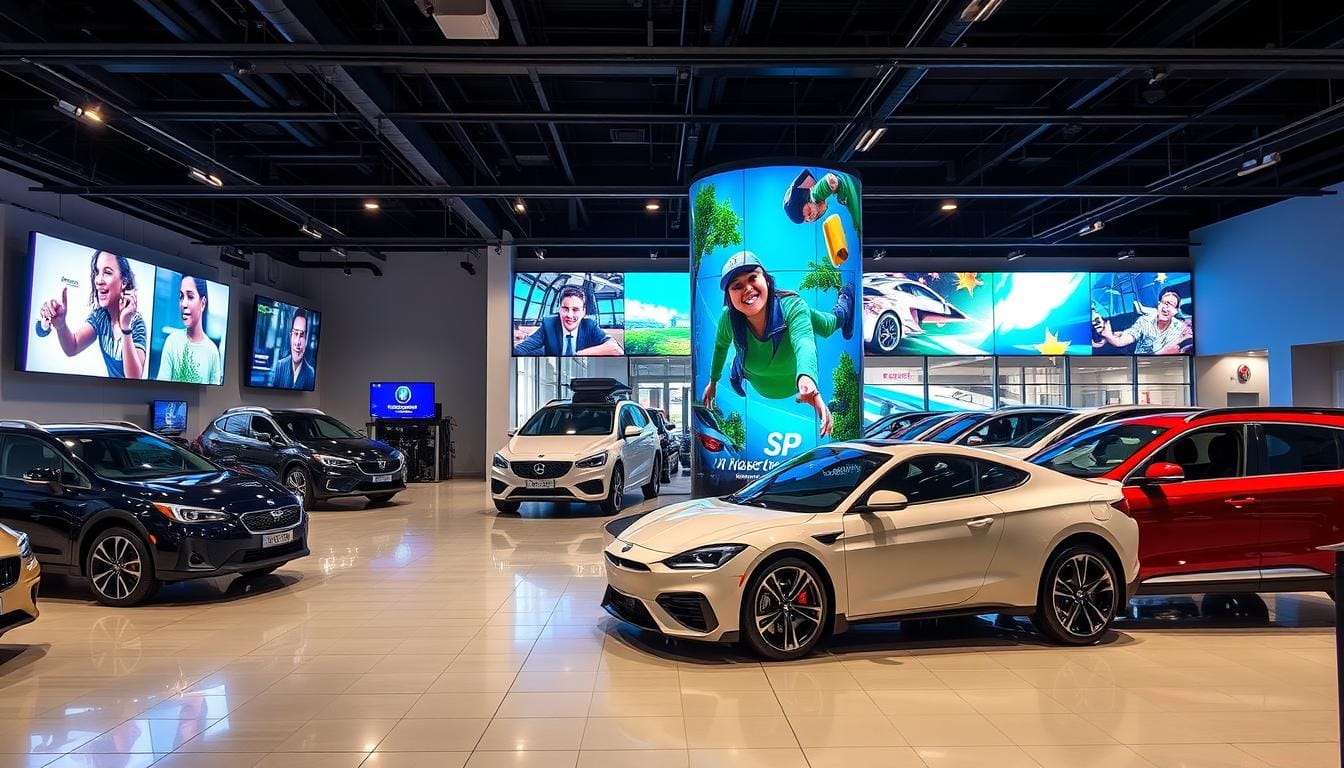Did you know digital signage can boost customer engagement by up to 70% in car dealerships? This shows how powerful automotive digital signage is. It makes the customer experience better and builds loyalty. With tools like video walls and personalized messages, customers interact more than ever.
By using digital systems, you can meet and exceed customer expectations. This is key in a competitive market.
In today’s marketing world, automotive digital signage is a game-changer. These signs do more than show videos and specs. They take customers on a journey of discovery. Imagine picking your dream car on an interactive screen. It’s not just shopping; it’s a personal experience.
Key Takeaways
- Automotive digital signage can increase customer engagement by up to 70%.
- Digital signs enhance customer interaction through video walls, self-service kiosks, and interactive displays.
- Using digital signage in showrooms creates an engaging and educational car shopping experience.
- Interactive kiosks can boost customer personalization and engagement by 30%.
- Touchscreen displays increase customer confidence in their purchase by 40%.
What is Gamification in Automotive Digital Signs?
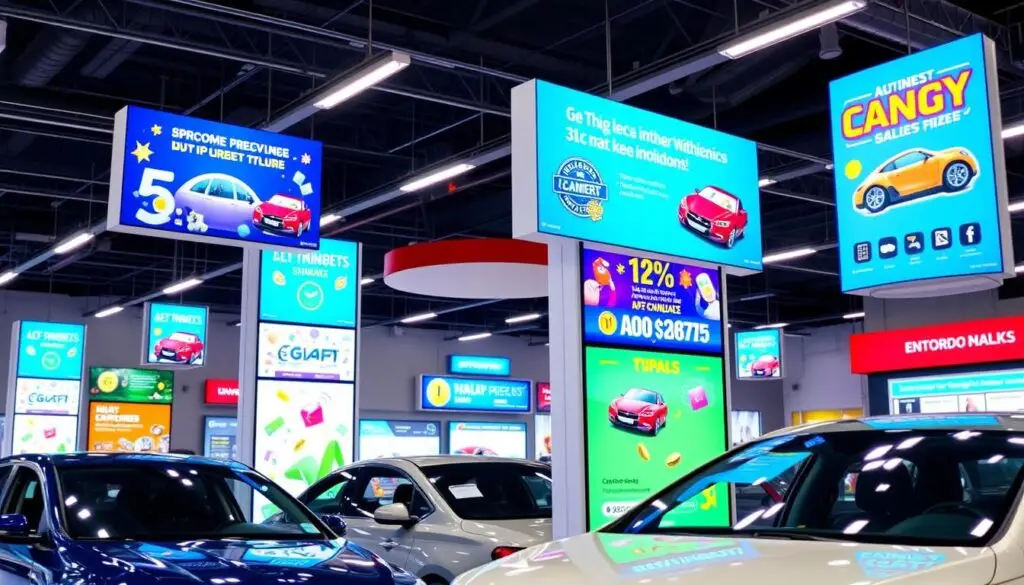
Automotive digital signage is changing the game with electronic displays that grab attention. These displays, from touchscreens to dynamic posters, make shopping fun and educational. They make the buying journey better for customers.
Definition and Overview
It’s key to understand what gamification means for digital signs in cars. It uses game elements to make marketing more engaging. This approach has made old marketing ways fresh and important in today’s world.
- Digital signs grab 63% more attention than billboards, TV, and the Internet.
- Dynamic signs boost engagement by 75%.
- They’re easy to update, helping meet marketing goals.
- By 2026, the gamification market is expected to grow by $22.77 billion.
Importance in Modern Marketing
Using gamification in car digital signs marks a big change in marketing. With people spending 10 hours a day on screens, dynamic signs get your message across better. Gamified content holds attention longer than static signs, making your business seem modern and tech-savvy.
The Role of Interactive Displays in Customer Engagement

In today’s car showrooms, interactive displays like touchscreen kiosks are key. They let customers easily pick vehicle options, making the buying process better. This makes their visit more memorable and impactful.
How Touchscreen Technology Enhances User Experience
Touchscreen technology makes the car shopping experience better. It lets customers directly interact with vehicle info. They can compare models and choose features that fit their needs.
Also, digital signage in car dealerships can change quickly. This means it can show new deals or updates fast. It keeps customers interested and informed, boosting their happiness.
Real-World Applications in Dealerships
Dealerships use big video walls, digital posters, and touchscreen kiosks. These help visitors get the latest info and deals easily. For example, systems like QueueBee’s digital signage keep content fresh and relevant.
Interactive displays also help build customer loyalty. They offer unique and personal experiences. By matching designs with the brand, they grab attention, leading to more sales and happy customers.
Innovative Customer Engagement: Gamification in Automotive Digital Signs

The world of automotive digital signs is changing fast. Now, they’re not just about showing cars. They’re about creating fun, interactive experiences that grab customers’ attention. Gamification turns a simple display into a lively, engaging event, making it easier for customers to interact and decide.
Unique Features and Benefits
Gamification in automotive digital signs uses game-like elements to make things fun and competitive. It includes:
- Points or virtual currency
- Leaderboards
- Challenges
- Onboarding actions
- Re-engagement tactics
- Maintaining visual and textual cohesion
Dealerships use these tools to make things exciting and new. This keeps customers coming back. It also encourages them to buy more than they planned, boosting loyalty and social media following.
Case Studies and Success Stories
Many industries have seen great success with gamification. Starbucks Rewards, for example, used points to keep customers coming back. McDonald’s Monopoly game increased sales by 6% in just a year. In cars, Michelin and Virgin used scavenger hunts to engage and reward customers, building brand loyalty.
| Company | Gamification Technique | Outcome |
|---|---|---|
| Starbucks | Point-based, tiered loyalty program | Increased loyalty, boosted sales |
| McDonald’s | Monopoly game | 6% sales increase |
| Michelin & Virgin | Scavenger hunts | Enhanced brand advocacy, geolocation promotion |
| Meow Cosmetics | Hidden egg hunt | Increased engagement, isolation relief |
| Duolingo | Leaderboards, streak maintenance | High motivation, 427-day streaks |
Using gamification in automotive digital signs is a smart move. It turns customer interactions into memorable experiences. This sets businesses apart in a crowded market.
Augmented Reality: A Game Changer for Automotive Digital Signs
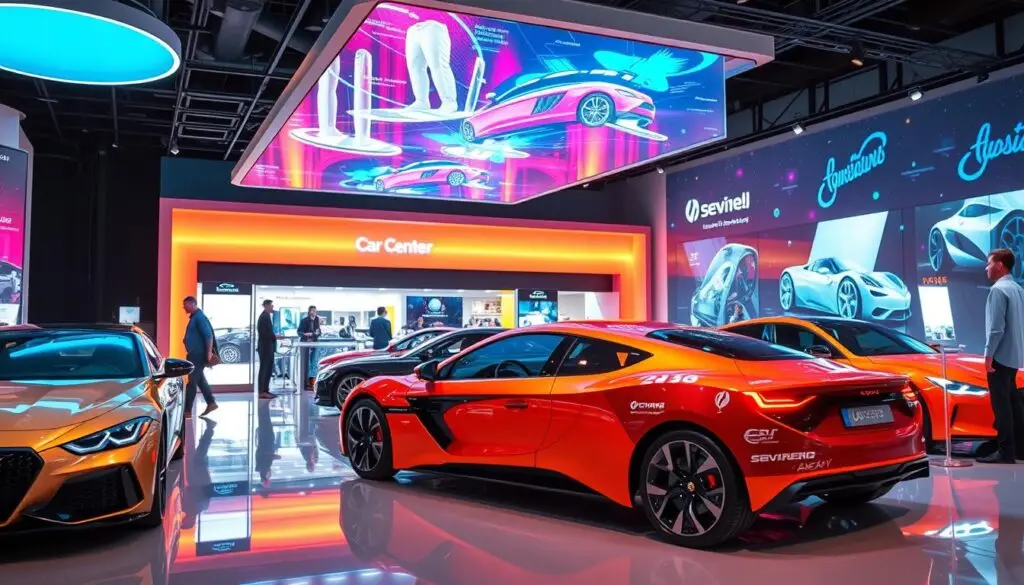
Augmented reality (AR) is changing the game for automotive digital signs. It offers immersive and memorable experiences. Brands are using AR to engage customers and improve how they see their products.
Interactive Experiences and Their Impact
AR lets brands create interactive experiences that grab and keep customers’ attention. Apple’s Apple Vision Pro is a great example. It mixes digital data with the real world, making car features come alive.
Another cool use is in train stations, like those in London and Birmingham. Lynx Cologne used AR for marketing stunts. This blend of physical and digital worlds is unique in automotive marketing.
Examples of Augmented Reality in Use
Starbucks has used AR in their loyalty programs. Customers unlock rewards through digital experiences. Automotive brands are using AR for virtual test drives, showing cars in new ways.
Lily, a Chinese brand, set up a pop-up store in Shanghai. It had interactive screens for virtual try-ons. Automotive marketers can use this to show off car accessories and customization options.
AR has also improved warehouse operations. Signs project product info and locations onto shelves. This could help the automotive industry with inventory management and parts retrieval.
| Aspect | Impact |
|---|---|
| Enhanced Engagement | Interactive and personalized customer experiences. |
| Marketing Efficiency | Real-time insights and refined strategies. |
| Buzz Creation | Unforgettable, shareable AR campaigns and promotions. |
| Customer Attraction | Engaging AR draws customers like honey attracts insects. |
| Conversion Rates | Measurable success through key performance indicators. |
AR in automotive marketing is making a big difference. It offers virtual test drives and interactive manuals. As AR gets better, it will keep pushing brands to be more engaging and innovative.
Touchscreen Technology: Transforming the Automotive Market

Touchscreen technology has changed the car market a lot. Modern showrooms use these screens to give customers a better experience. This makes shopping for cars more fun and helps customers make better choices.
Advantages of Touchscreen Displays in Showrooms
Touchscreens in showrooms have many benefits. They let customers look at car details, compare models, and pick features easily. This makes it more likely for customers to make good choices.
These displays also make showrooms more interactive. They show off cars and services in a cool way. This attracts more people who like using technology to explore cars.
Customer Feedback and Interaction
Touchscreens help dealers get feedback from customers. This feedback helps dealers know what customers want. It makes the showroom better for everyone.
Also, the data from these screens helps dealers see what works and what doesn’t. This keeps the showroom up-to-date with what customers want. It’s a win-win for everyone.
Designing the User Experience: Digital Signage and Gamification
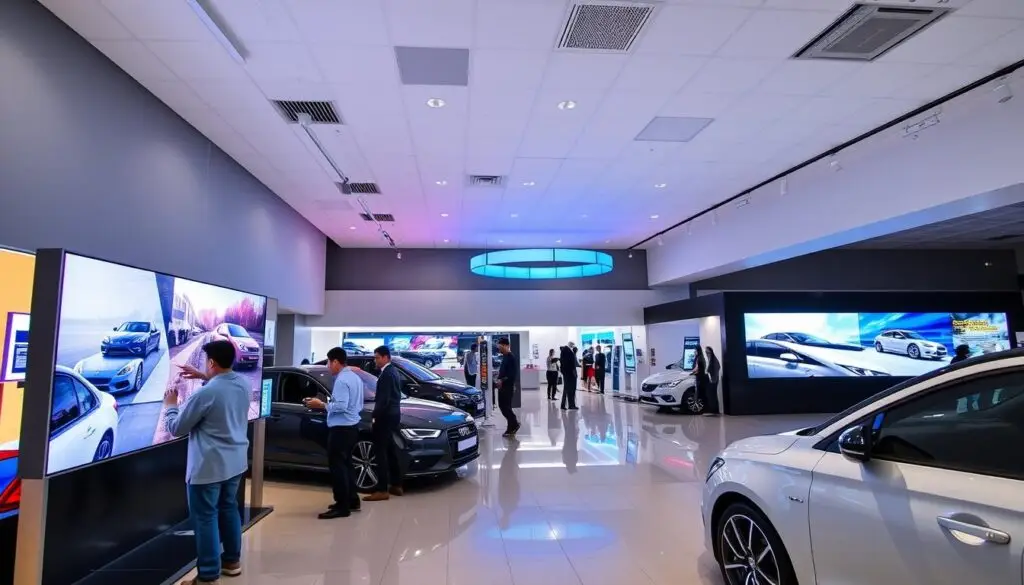
Creating interactive digital signage and gamification is key. It’s about mixing information with fun to engage users. Knowing how to do this makes the experience better and more enjoyable for everyone.
Principles of User Experience Design
The main ideas of user experience design are clear, engaging, and personal. Easy-to-use navigation helps users find what they need fast. Fun content keeps them coming back. Making things personal is also important, as Infosys found 86% of shoppers like it.
For example, Duolingo makes learning fun by adapting to your pace. It uses points and levels to encourage daily practice.
Balancing Engagement and Information
Getting the right mix of engagement information balance is crucial in digital signage. Gamification can really get people involved—Badgeville saw a 50% boost. Things like Foursquare’s “Mayors” challenge or LinkedIn’s profile progress bars make users want to do more.
McKinsey & Company also found that being personal can increase sales by up to 10%. This shows how important it is to meet individual needs in the interactive journey.
| Principle | Example | Impact |
|---|---|---|
| Clear Navigation | LinkedIn Profile Bar | Higher Profile Completion Rates |
| Engaging Content | Foursquare Mayorship | Increased Venue Visits |
| Personalization | Duolingo Adapted Lessons | Enhanced Learning Experience |
Boosting Customer Retention and Brand Loyalty through Gamification
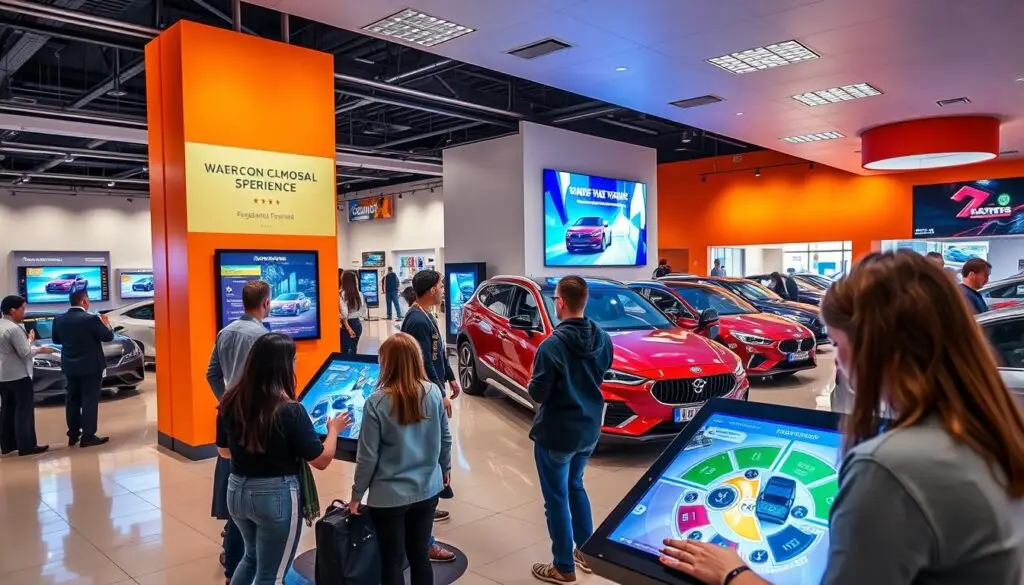
Gamification is a powerful tool for keeping customers coming back and building loyalty. It adds game-like elements to non-game areas. This helps businesses, like those in the automotive field, connect better with their audience.
Strategies for Repeat Engagement
Keeping customers coming back is key to a loyal base. Starbucks and Nike have shown how gamification can work. Starbucks rewards frequent visits with stars and levels. Nike’s NikeFuel app gets users competing in fitness activities.
- Personalized Campaigns: Make your gamification efforts match each customer’s interests and preferences. This makes them feel valued and understood.
- Interactive Experiences: Create fun experiences that make customers want to keep coming back to your brand.
- Incentives: Give rewards that match what customers do, like points, discounts, or early access to new products.
It’s cheaper to keep an existing customer than to get a new one. Repeat customers also spend more than new ones. So, using gamification can save money and increase profits.
Building a Loyal Customer Base
To build a loyal base, consistently deliver value and show appreciation. For example, the Victoria’s Secret PINK Nation app uses gamification to connect with young people through challenges and rewards.
- Balance Individual Needs: Make sure loyalty programs meet different customer preferences. This creates a sense of belonging.
- Engage with Gamification: Let your customers be part of your brand’s community. This can increase engagement by up to 48%.
- Transform Customers into Advocates: Use gamification to build stronger relationships. This encourages customers to become brand advocates.
Successful gamification needs a good understanding of key principles and best practices. Brands like Zappos and Duolingo show how rewarding actions can boost loyalty and engagement.
A well-thought-out gamification strategy can increase engagement and loyalty. This helps your business succeed in a competitive market.
| Company | Gamification Application | Outcome |
|---|---|---|
| Starbucks | My Starbucks Rewards | Increased customer visits |
| Nike | NikeFuel App | Enhanced fitness engagement |
| Victoria’s Secret | PINK Nation App | Youth engagement through gamification |
| Zappos | Rewards for Reviews | Higher customer review submissions |
Gamification in Experiential Advertising for the Automotive Industry
Experiential advertising has changed the game in automotive industry marketing. It has brought new ways to engage with customers. Brands now use gamification to stand out from old-school ads.
Examples of Experiential Campaigns
Many car brands have run successful campaigns. Audi set up immersive experiences that let people try out driving challenges. Ford used augmented reality to let users explore new cars in a virtual world.
These gamification campaign examples show how to make ads more engaging. They offer a unique experience that traditional ads can’t match.
Benefits Over Traditional Advertising
These campaigns have many benefits. They help people remember ads better than old-school ads. By making ads interactive, brands build stronger connections with customers.
The growth in gamification technologies for cars is huge. It’s expected to grow by 23.20% from 2016 to 2025. This shows how much people want interactive and memorable ads.
These new ideas also open up many business and tech options. From SaaS to VR, there’s a lot to explore. North America and Europe are leading the way, offering lots of chances for innovation.
Conclusion
Using gamification in car digital signs is a smart way to make experiences better for customers. It keeps up with the changing industry. Dealerships and makers can make lasting connections with their brand. This leads to more sales and loyal customers.
Studies show gamification works well. Personalized videos can get people to engage online by 50%. Augmented reality boosts customer interest by 40%. These new ways of showing off cars are not just reaching more people. They’re also building strong customer groups, growing up to 25% a year.
Using these modern methods in cars brings real benefits. For example, keeping customers happy with personalized stuff can increase retention by 30%. Loyalty programs can keep customers coming back by 20%. Mixing social media with gamification can grow your brand by 70%. This shows a big jump in how customers feel about your brand, up to 15 points.
When you start using these ideas, make sure to stay fresh and focused on the customer. This will help you keep up with the changing world of cars.
FAQ
What is gamification in automotive digital signs?
Gamification in automotive digital signs uses interactive elements to engage customers. It lets users customize their cars and play games. This makes shopping more fun and interactive.
How does gamification enhance the customer experience in automotive showrooms?
Gamification makes the experience more interactive and personal. Touchscreen kiosks and augmented reality let customers see car features and play games. They also get personalized info, making the buying process more enjoyable.
What role do interactive displays play in automotive marketing?
Interactive displays, like touchscreen kiosks and video walls, are key in automotive marketing. They offer engaging experiences for customers. Customers can explore vehicles, view promotions, and even customize their dream car, enhancing their journey.
How do augmented reality and gamification in automotive digital signs impact customer engagement?
Augmented reality and gamification boost customer engagement with immersive experiences. AR lets customers see car features and modifications realistically. Gamification elements motivate customers to engage more with the brand.
What are the benefits of using touchscreen technology in automotive showrooms?
Touchscreen technology in showrooms gives customers easy access to information. They can explore vehicle features, compare models, and view promotions. This leads to more informed decisions and a personalized shopping experience.
How can user experience design improve automotive digital signage?
Good user experience design makes digital signage intuitive and engaging. It focuses on clear navigation, compelling content, and personalized experiences. Dealerships can create a seamless and enjoyable journey, boosting satisfaction and loyalty.
What are some successful strategies for using gamification to boost customer retention in the automotive industry?
Successful strategies include personalized campaigns and interactive experiences. For example, Toyota’s Christmas campaign used gamification to boost engagement and loyalty.
How does experiential advertising using gamification benefit automotive brands?
Experiential advertising through gamification engages consumers in memorable ways. It enhances brand recall and builds emotional connections. This leads to increased loyalty and stronger brand affinity.


